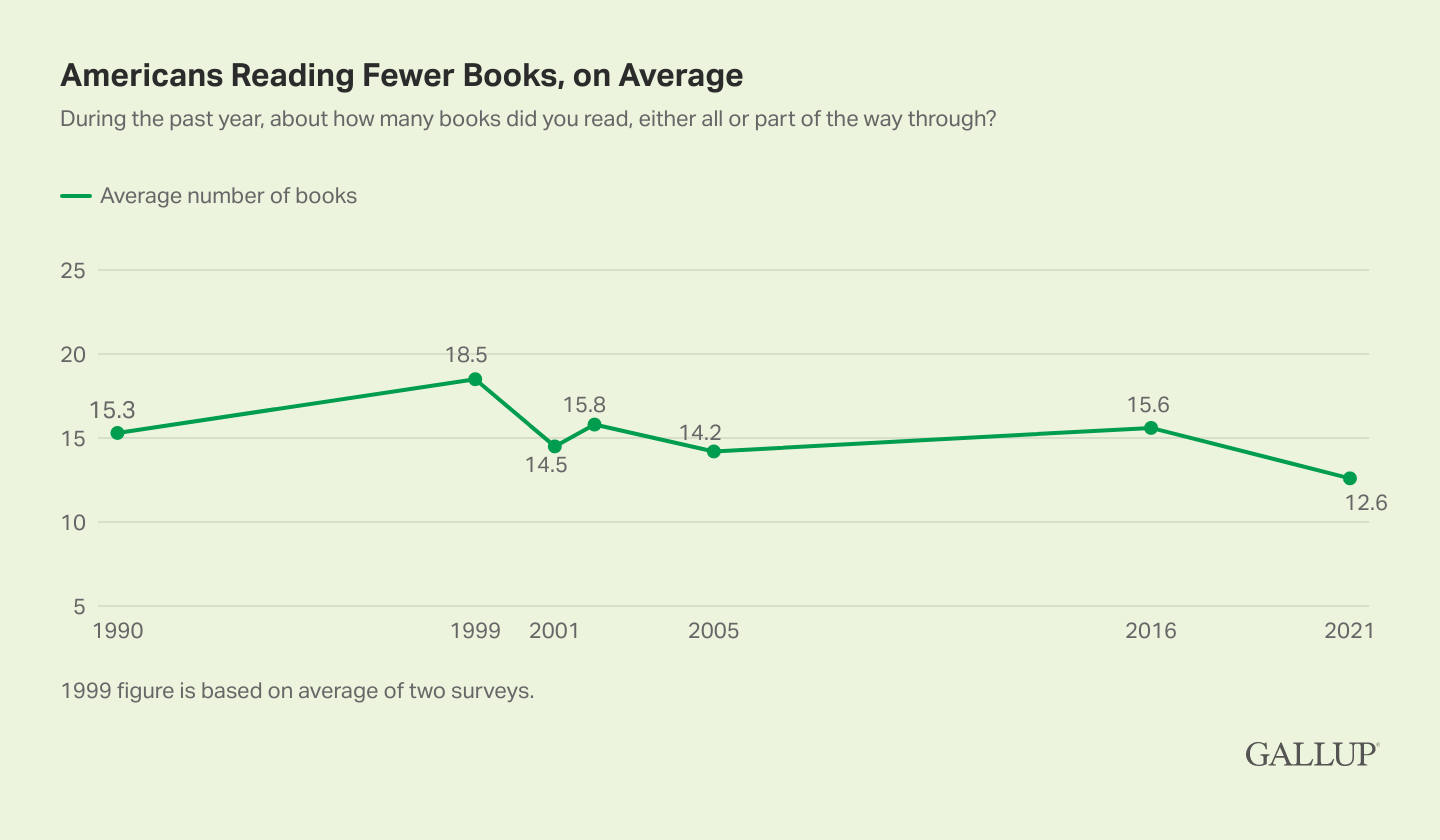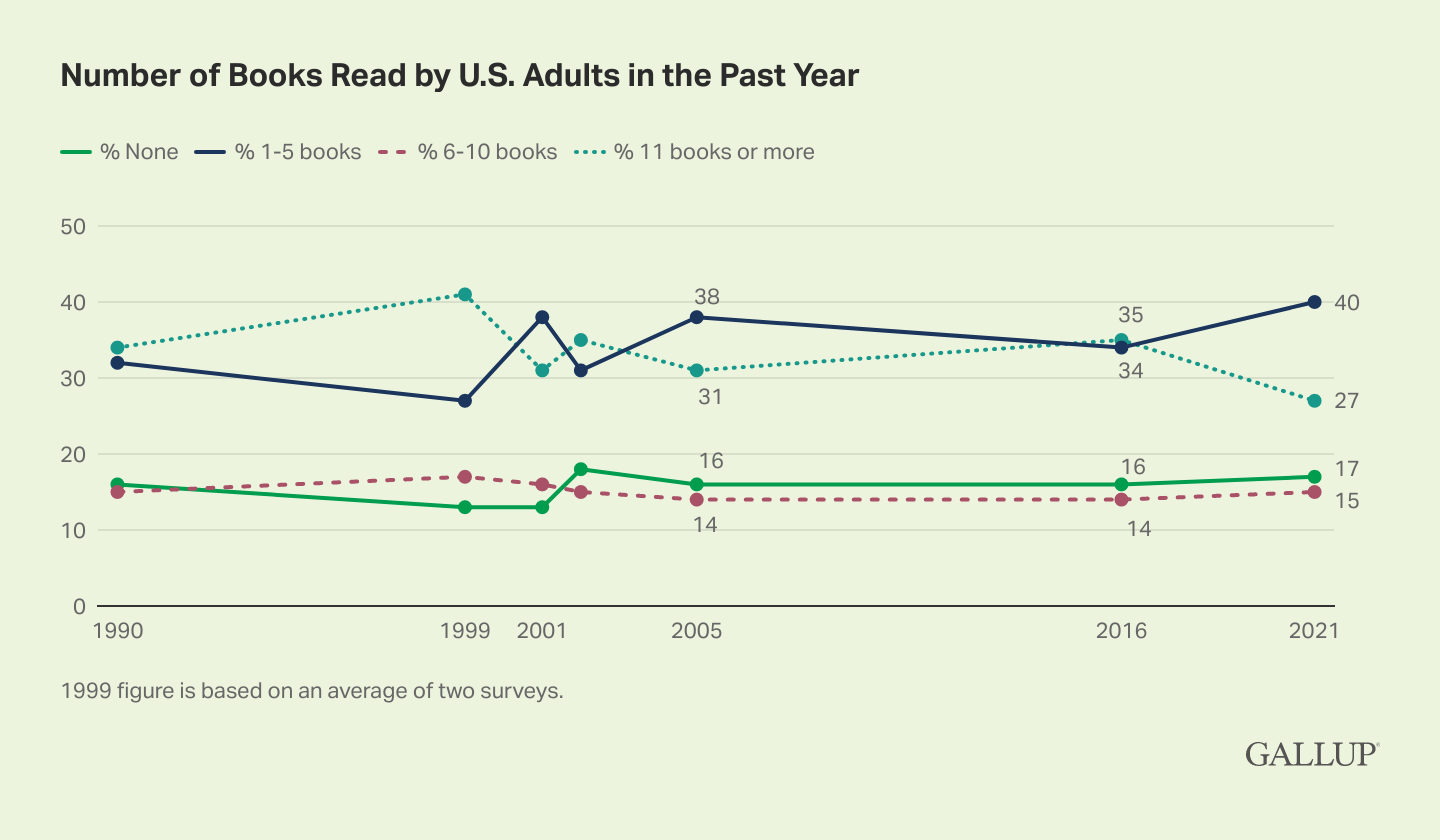Story Highlights
- Average number of books read down to 12.6 from 15.6 in 2016
- Percentage reading any books is stable; fewer are reading more than 10
- College graduates show largest decline in number of books read
WASHINGTON, D.C. -- Americans say they read an average of 12.6 books during the past year, a smaller number than Gallup has measured in any prior survey dating back to 1990. U.S. adults are reading roughly two or three fewer books per year than they did between 2001 and 2016.

Line graph. Trend in average number of books Americans say they read in the past year. The 12.6 average for 2021 is down from 15.6 in 2016 and lower than any other year Gallup asked the question, including 14.2 in 2005, 15.8 in 2002, 14.5 in 2001, 18.5 in 1999 and 15.3 in 1990.
The results are based on a Dec. 1-16 Gallup poll, which updated a trend question on book reading. The question asks Americans to say how many books they "read, either all or part of the way through" in the past year. Interviewers are instructed to include all forms of books, including printed books but also electronic books and audiobooks, when entering the respondent's answer.
The decline in book reading is mostly a function of how many books readers are reading, as opposed to fewer Americans reading any books. The 17% of U.S. adults who say they did not read any books in the past year is similar to the 16% to 18% measured in 2002 to 2016 surveys, though it is higher than in the 1999 to 2001 polls.
The drop is fueled by a decline in the percentage of Americans reading more than 10 books in the past year. Currently, 27% report that they read more than 10 books, down eight percentage points since 2016 and lower than every prior measure by at least four points.

Line graph. Trend in number of books Americans say they read in the past year. In 2021, 17% of U.S. adults said they read no books in the past year, about the same percentage as in the prior reading in 2016 and similar to most readings since 1990. At the same time, there was a decline in the number reading more than 10 books, from 35% in 2016 to 27% in 2021. That decrease was offset by an increase in the percentage reading 1 to 5 books, from 34% to 40%. The percentage reading six to 10 books was steady at 15%.
The reasons for the decline in book reading are unclear, with Americans perhaps finding other ways to entertain themselves. It is uncertain whether concerns about COVID or COVID-related restrictions are leading to a decline in visits to libraries or bookstores, similar to the documented declines in air travel and movie theater attendance Gallup found in the same poll. However, unlike those activities, for reading, Americans can order books or download electronic books or audiobooks without leaving their homes.
College Graduates Show Steep Decline in Book Readership
Americans in most major subgroups are reading fewer books now than in the past. This is based on a comparison of the 2021 results to an average of those from the three polls conducted between 2002 and 2016. During those years, Americans read an average of 15.2 books a year.
The decline is greater among subgroups that tended to be more avid readers, particularly college graduates but also women and older Americans. College graduates read an average of about six fewer books in 2021 than they did between 2002 and 2016, 14.6 versus 21.1.
In the past, women read close to twice as many books as men did, but the gap has narrowed as the average U.S. woman read 15.7 books last year, compared with 19.3 between 2002 and 2016. Over the same period, men's readership declined by barely one book, to 9.5.
Older adults traditionally read a lot more than younger adults did, but that difference has vanished, with Americans aged 55 and older dropping from an average of 16.7 books read a year to 12, while there has been little change in the average number read by those younger than 55.
| 2002-2016 | 2021 | Change | |
|---|---|---|---|
| U.S. adults | 15.2 | 12.6 | -2.6 |
| Gender | |||
| Men | 10.8 | 9.5 | -1.3 |
| Women | 19.3 | 15.7 | -3.6 |
| Age | |||
| 18-34 years | 13.8 | 13.0 | -0.8 |
| 35-54 years | 14.2 | 12.5 | -1.7 |
| 55+ years | 16.7 | 12.0 | -4.7 |
| College graduate | |||
| Yes | 21.1 | 14.6 | -6.5 |
| No | 12.6 | 11.5 | -1.1 |
| Gallup | |||
Again, reduced book reading among these groups is more a function of fewer people reading larger numbers of books than fewer in the subgroup reading at all. Between 2002 and 2016, close to half of college graduates (48%) read more than 10 books in a year. Last year, 35% of college graduates read more than 10 books.
Similarly, the percentage of older adults reading more than 10 books fell from 34% to 24%, while the percentage of women reading that many books dropped from 41% to 32%.
Bottom Line
Reading appears to be in decline as a favorite way for Americans to spend their free time. In 2020, a few months into the COVID-19 pandemic, when many Americans were still reluctant to leave their homes, Gallup found 6% of U.S. adults naming reading as their favorite way to spend an evening, down from 12% in 2016. Since Gallup first asked the question in 1960, at least 10% of Americans had identified reading as their favorite evening activity in all but one survey.
The new data on book reading reinforce that the popularity of reading is waning, with Americans reading an average of three fewer books last year than they did five years ago and had typically read for the past three decades. The decline is not because fewer Americans are reading at all -- a percentage that has held steady at 17% -- but because Americans who do read are reading fewer books. The changes are especially pronounced among the most voracious book readers, namely, college graduates, women and older Americans.
It is unclear from these data if the declines in book readership are occurring because of a lack of interest in books, a lack of time to read books, or perhaps COVID-19-related disruptions in lifestyle activities or access to books. It is also uncertain at this point whether the declines in book reading mark a temporary change or a more permanent one.
To stay up to date with the latest Gallup News insights and updates, follow us on Twitter.
Learn more about how the Gallup Poll Social Series works.




